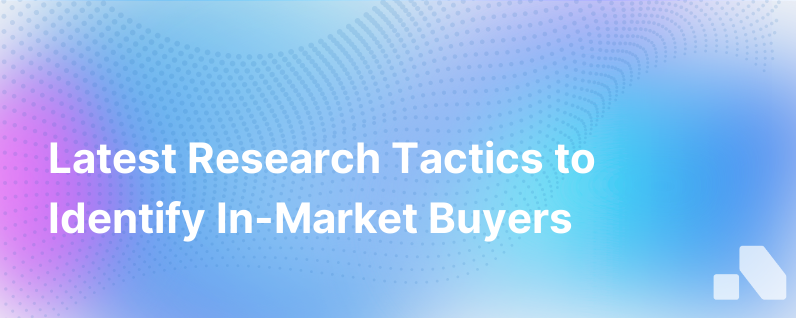Latest Research How Marketers Identify In Market Buyers
Published on November 26, 2023 by David Zhang
In today’s rapidly evolving digital landscape, marketers are constantly seeking innovative strategies to identify buyers when they are in the market for their products or services. This targeted initiative not only streamlines the path to purchase but also amplifies the efficiency of marketing campaigns and sales efforts. The latest wave of research reveals fascinating insights into how savvy marketers are leveraging data, technology, and behavioral analysis to pinpoint buyers at their most receptive moments.
This exploration unpacks the blend of art and science employed by modern marketers to ascertain in-market buyers, thus enabling them to deliver timely, personalized content that resonates, engenders trust, and ultimately, converts to sales.
Harnessing Predictive Analytics and AI
The cutting-edge battleground for marketers in detecting in-market buyers is predictive analytics, an area where artificial intelligence (AI) and machine learning (ML) play pivotal roles. By analyzing extensive datasets to predict which customers are likely to make a purchase, AI's algorithmic prowess is a game-changer.
More specifically, AI systems can process historical data, consumer behavior patterns, and engagement analytics to forecast buying signals. These signals could be as overt as a surge in website visits or product inquiries or as subtle as changes in engagement levels with marketing emails.
Beyond lead scoring, the granularity extends to merging various data streams, such as social media activity, CRM data, and market trends, to yield multi-dimensional portraits of buyer readiness. It's not just about a surge in behavioral data but a richer, deeper analytical context that signals intent.
Intent Data and Real-time Signals
Intent data is information collected about a web user's behavior that suggests a predilection to make a buying decision. It's the cornerstone for modern marketing efforts – highlighted by a user's content consumption patterns or engagement with certain topics, products, or solutions online.
Marketers are using intent data in tandem with real-time engagement signals to deliver highly targeted campaigns. Tools like Bombora and ZoomInfo mine such consumption patterns to inform sales and marketing teams of businesses actively researching online. This integration of intent data illuminates the buyer's journey, making it feasible to engage potential customers earlier.
Account-Based Marketing (ABM) Strategies
Account-based marketing refines the marketers' focus to the most valuable prospects – flipping the traditional marketing funnel on its head. Instead of casting a wide net and hoping to capture interested parties, ABM targets key accounts projected to deliver significant ROI.
The latest research underscores that ABM isn’t just about targeting; it’s also about timing. By sniping the accounts that exhibit buying signals and are positioned for a sales discussion, ABM practices can personalize communication to a degree that accelerates the buyer’s journey towards purchase.
ABM technologies play a significant role in this targeted approach, leveraging AI to segment and pinpoint high-value targets and determine the optimal time for engagement based on readiness indicators.
Layering Psychographic Profiling Over Demographic Data
While demographic data has long been the bedrock of understanding the "who" of potential buyers, psychographics answer the "why" behind their behaviors and decisions. Recent advancements in data analysis allow marketers to craft psychographic profiles – lists of interests, values, lifestyles, and personality traits that influence purchasing behavior.
Layering these over foundational demographic insights has given skilled marketers a multidimensional understanding of their audience's motivations – providing a predictive edge when it comes to spotting likely in-market buyers.
Social Listening and Community Engagement
The ubiquity of social media has created immense opportunities for monitoring real-time conversations and sentiment around brands, products, or industry trends. Social listening tools scour these digital ecosystems for relevant chatter that indicates market readiness – such as discussions on pain points, product asks, or competitor mentions.
Community engagement on platforms like LinkedIn or industry forums can also reveal nuanced insights into buyer intent. Marketers adept at interpreting this conversational data can adjust their strategies accordingly, targeting users who are signaling interest or seeking solutions that their product addresses.
Integration of Content Experience Platforms
Content continues to serve as a valuable asset in identifying in-market buyers. Tools that assess the interaction with content, such as video play rates or content download metrics, feed back into the predictive models to score and gauge sales readiness.
Platforms that enhance the content experience, like PathFactory, allow marketers to serve contextually relevant and highly personalized content – serving the dual purpose of educating the buyer and signaling when they are primed for sales discussions.
Conclusion
The convergence of sophisticated analytics, AI-driven insights, and digital behavior tracking has ushered in a new era of precision in identifying in-market buyers. Today’s marketers are equipped with an arsenal of technologies and strategies to decipher and act upon buyer signals at scale, delivering significant advantages over traditional means of lead generation and nurturing.
The tapestry of rich data, real-time analytics, and intelligent targeting has created a more efficient and effective marketing ecosystem where personalization and timeliness isn’t just possible – it’s imperative for success. With this evolving toolkit at their disposal, savvy marketers stand poised to not only identify but also engage and convert in-market buyers with unprecedented dexterity and results.
While the strategies highlighted encapsulate the current state of the art, ongoing innovation suggest they will continue to evolve, with platforms like Aomni staying ahead of the curve by integrating these techniques into service offerings that drive even deeper engagement and ROI for businesses.